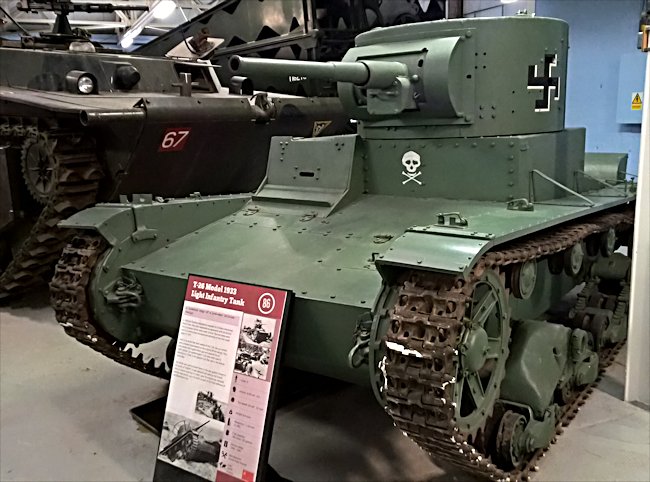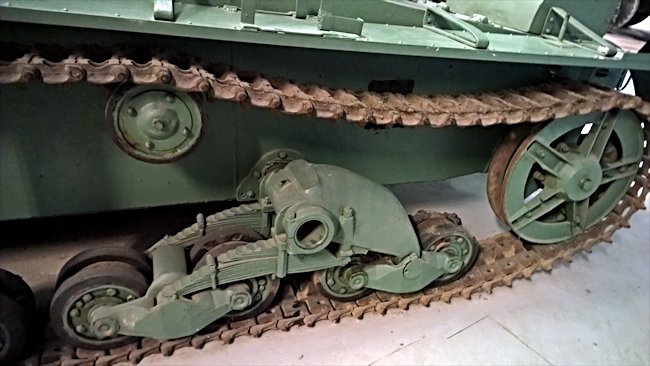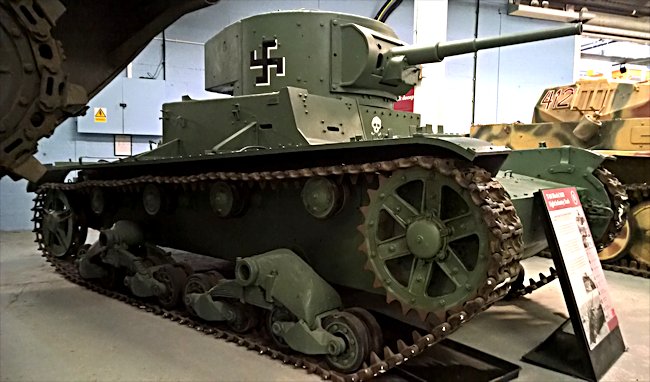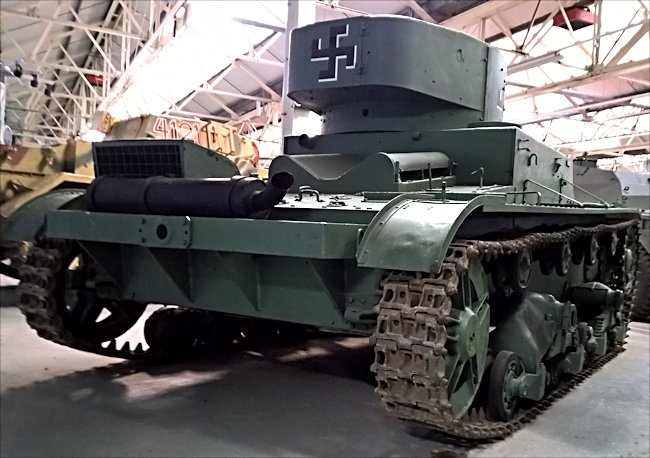Finnish Army T-26 Soviet Light Tank Ps-163-8
This Soviet T-26 tank, modeled on the British Vickers-Armstrong Mark E tank, can be found at the Tank Museum, Bovington, Dorset, England. The swastika was used by the Finnish Army in WW2, The sign means good luck. It is considered to be a sacred and an auspicious symbol in Hinduism, Buddhism, and Jainism and dates back at least 11,000 years.

Soviet WW2 T-26 Tank captured by the Finnish and painted in their markings (not German markings)
Finland's Wars
The Winter War was against the Soviet Union 30th November 1939 to 13th March 1940 -tentatively support by Sweden, Britain and France and lesser extent USA. Russo-Finish War also called the Continuation War, Germany as a co-belligerent June 25, 1941 – 15th September 1944 and finally the third phase the Lapland War 15th September 1944 – 25 April 1945 Finland aligns with Soviets against German forces in Finland and Swedish Lapland.
The T-26 tank
In the 1930's members of the new Russian Army had the chance of examining the Mark E tank built by the British company Vickers-Armstrong. The British Army did not take up the option of placing an order for this tank so the company started a sales drive to foreign military forces. The Soviets negotiated a contract where they were able to build a modified Mark E tank under licence in a Russian factory near Leningrad. Eventually 11,000 were built in 53 different variations.
They named their version of the British tank the T-26. The first one off the production line in 1931 was the T-26 model 1931. They had two twin machine gun turrets for infantry support. It was a mobile machine gun post. Normally two 7.62mm DT Degtyaryov machine guns were installed rather than the British Vickers machine gun. These DT machine guns were modified versions of the infantry weapon specifically designed for use in armoured vehicles.

Soviet WW2 T-26 Tank captured by the Finnish and painted in their markings (not German markings)
Later versions of the T-26 had a 45 mm 20K mod 1932-34 tank gun fitted in a two man turret with a coaxial 76.2 mm DT machine gun. The T-26 along with the BT series of tanks were the most important tanks during the Spanish Civil War for the Republicans. The German panzer I and II tanks of the Condor Legion found it problematic to knock out these red army tanks. They were also used against the Japanese army in the border conflicts that occurred in 1938 and 1939.
When most people think about WW2 Russian tanks they instantly consider the T34/76, T34/85 and the KV series of tanks. The T-26 Soviet light infantry tank was the most numerous tank on the battlefield when the Germans invaded Russia in June 1941. Although obsolete they stayed in operational service until there were enough T34 tanks to replace them.

Soviet WW2 T-26 Tank captured by the Finnish and painted in their markings (not German markings)
This tank was used by the Soviet Army as part of its invasion force that attacked Finland in the Winter of 1940/41. The Russians were looking for a quick victory but that never happened. This Russian T-26 light tank was captured by the Finnish Army and used against its previous owners. They painted their insignia on the back and side of the turret. They used a Swastika like the German Nazi party. It survived the war because its engine was taken out and its hull buried up to its turret. it became a part of the fixed defenses of the Manneheim Line that was built by the Finnish army just north of the boarder with the Soviet Union.

Rear view of the captured T-26 tank
The T-26 tank had a crew of three: commander, gunner and driver. Its thin protective armour ranged from 6 mm to 15 mm and it weighted 9.6 tonnes. It could carry 122 shells for the main gun and had a top road speed of 19 mph (31.1 km/h). Off road it could only manage just under 10 mph (16 km/h)
How did the Finns capture this tank?
According to Dave Schofield of the Bovington Tank Museum the holes in the rear armour of this T-26 Tank were caused by Finnish 20mm anti tank rounds. They are exit not entry holes. There are two dents above the holes that were caused by more 20mm rounds that never exited the tank. These holes in the back of the tank were not repaired by the Finns. A Finnish solider got close enough to the tank to be able to put the barrel of his semi automatic 20mm anti-tank rifle through the driver's vision slit and open fire. The two rounds that did not go through the armour had lost speed and penetrative power as they had passed through the body of the Soviet driver.
The stamped in chassis number Ps-163-8 found on this tank, indicating this was the 8th T-26 pressed into Finnish Army use. It became part of the fixed gun emplacement fixed defenses of the Mannerheim line after it was gutted internally for spare parts. The arms of the swastika should be longer and the skull and crossed bones unit marker painted yellow to correctly match those used by the Finnish forces in 1941.
This tank came to the Tank Museum as a result of work done by the Friends of the Tank Museum. Friends travelled to Finland to restore a Comet Tank and by way of thanks the Tank Museum received this T26 and a Sturmi (Stug III). This work was coordinated by the late John Gillman OBE.
WW2 tank books

